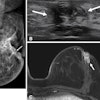SAN FRANCISCO - MRI has been a great boon to stroke researchers who are probing the depths of white matter and the reasons for its dysfunction. But standard MR has its limits in this beautiful and complex structure, according to a presentation at the 2007 International Stroke Conference, hosted by the American Heart Association (AHA) and the American Stroke Association (ASA).
"We've known the importance of white matter for quite some time," said Glenn Stebbins, Ph.D., in his talk on Wednesday. "René Descartes originally thought white matter was a conduit through which 'animal spirits' ... were deposited throughout the body ... and affected our behavior. Thomas Willis was the first to distinguish between cortical gray matter and white matter, which conducted the information from the spirits out to the body. What was very important was Willis' discovery that the destruction of white matter blocked the flow of these sprits and resulted in changes in behavior."
"We're nowhere near describing the beauty and complete structure of white matter. (White matter) really is responsible for everything beyond the simplest function of the brain," added Stebbins, who is from Rush University Medical Center in Chicago. "We've been limited in our ability to describe white matter by many factors. Even with modern imaging techniques, we're limited in our ability to localize the effects of white-matter damage on higher functioning of the brain."
But recent advances in MR technology should unlock some of the mystery surrounding white matter, said Stebbins, who outlined a few of the MR techniques that stroke specialists should look forward to using.
First, Stebbins pointed out that present MR sequences, such as T2 relaxation, has allowed for the pathological quantification of white matter. Processing techniques, such as semiautomated and fully automated processing, have also contributed to a greater understanding of this part by allowing clinicians to not only delineate individual neurological components (white matter, gray matter, cerebral spinal fluid), but also to compare these components among groups of patients.
One of the newer techniques that has already offered greater insight into white matter is magnetization transfer imaging (MTI), Stebbins said. MTI looks at the ratio between bound and unbound protons. An increase or decrease in this ratio is indicative of the integrity of myelin.
"MTI has been looked at in white-matter hyperintensities in asymptomatic elderly individuals, and has shown a decrease in these hyperintensities. In addition, it's been shown that there is a slight decline in the ratio in normal-appearing white matter with age," he said. "So as we grew older, the ratio declines slightly. This decline is accentuated in specific regions of the cerebrum, including the frontal lobes and the parietal-occipital regions."
However, MTI still has some drawbacks: an "idiosyncratic" pulse sequence whereby slight changes can affect MTI measurements, as well as a complex postprocessing procedure, Stebbins cautioned.
Another newer technique is T2 relaxation imaging, which has mostly been used in rodent stroke models. But a handful of studies in humans indicated that the ratio between short T2 and total T2 signal is a good representation of the myelin fraction in the brain, Stebbins said.
"The scanning time for these studies is typically long, about 25 minutes although new pulse sequences and algorithms are being developed all the time to shorten that scanning time down," he added. "In addition, the use of the eight-channel head coil improves the quantification of the T2 relaxation time measurement."
Two MR techniques that are already in frequent use are MR spectroscopy (MRS) and diffusion tensor imaging (DTI). MRS focuses on the chemical composition of white matter and has proved useful for assessing neuronal and membrane integrity. It also may serve as a better predictor of cognitive impairment following stroke, Stebbins said.
DTI "allows us to detect 3D motion of hydrogen in the brain, both for magnitude and direction, and gives us a measure of anisotrophy, which is the shape of the diffusion," he stated. "It's the degree to which the diffusion differs in three dimensions." DTI offers insights into the white-matter differences between stroke patients with cognitive impairment and those without. It can be used to evaluate white-matter integrity in relation to psychomotor processing speed, Stebbins added.
"(With DTI), by looking at the coherence of the direction between neighboring voxels, one can begin to develop a description of the white-matter brain pathway in the brain," he explained.
Finally, there is the promise of ultra-high-field magnets (7- to 9-tesla), which will enhance the previously mentioned methods. Higher-field-strength magnets will allow for better resolution in DTI tractography, as well as smaller samples (submillimeter) for MRS. Also, instead of imaging hydrogen, stronger magnets will allow for the imaging of sodium at the level of ion exchange across the axon, Stebbins said.
"I think by putting these together, we are going to be in position to do multimodal combination imaging to better explain white matter, its damage, and its relation to (cognitive) function," he said.
By Shalmali Pal
AuntMinnie.com staff writer
February 9, 2007
Related Reading
MRI should be preferred test for suspected acute stroke, January 26, 2007
MRI-detected lesions may predict recurrent stroke, December 12, 2006
MRI spots white-matter changes in movement disorder patients, November 24, 2006
MRI profiles predict utility of reperfusion therapy for stroke, November 22, 2006
MRI helps identify ischemic stroke patients likely to benefit from tPA, May 8, 2006
Copyright © 2007 AuntMinnie.com



.fFmgij6Hin.png?auto=compress%2Cformat&fit=crop&h=100&q=70&w=100)




.fFmgij6Hin.png?auto=compress%2Cformat&fit=crop&h=167&q=70&w=250)











